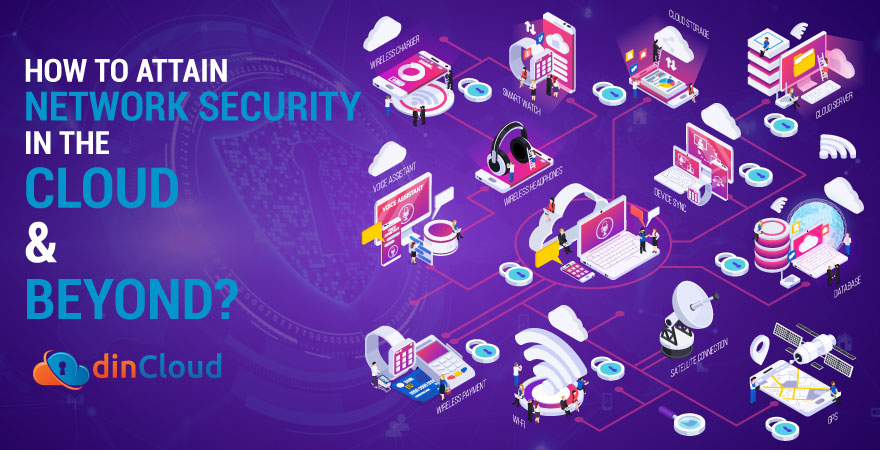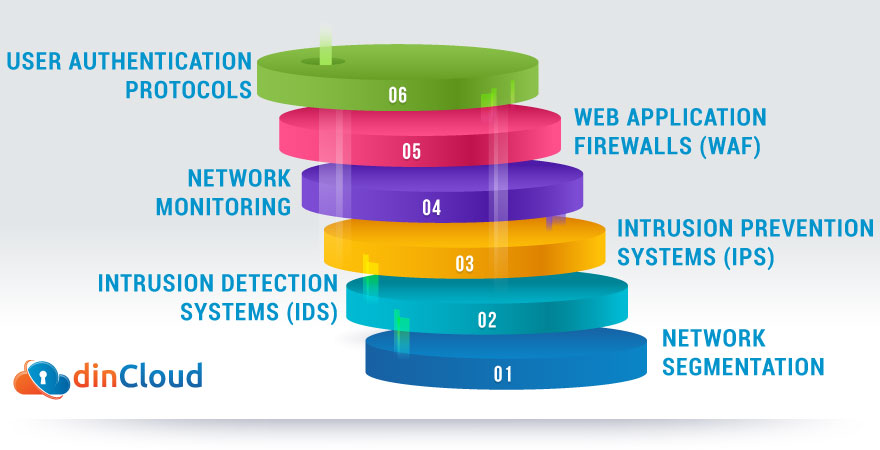The cloud is serving as a lifeline for millions of businesses across the globe. The present circumstances have only accelerated the already healthy adoption rate of cloud powered services and solutions across the globe.

Cloud Computing Landscape
If we analyze the existing cloud computing landscape, we will see a wide range of cloud-based services and solutions. This is an era of unprecedented integration and coexistence of varying degrees of cloud deployments. Let’s first cover the few basic cloud models.
Single Cloud Solution
In this deployment model, the entity in questions completely abandons its on premise IT infrastructure and shifts to a Cloud Service Provider (CSP) like dinCloud. From a network security perspective, this is one of the easiest deployments to secure.
Hybrid Cloud Model
In a hybrid cloud scenario, some organizational workloads are retained over the on premise IT infrastructure. The remaining workloads or processes are outsourced to a cloud provider like dinCloud. This is a relatively difficult architecture to secure.
Related: Top 8 Hybrid Cloud Computing Expectations for 2020
As the workloads are distributed in this scenario, there will certainly be some degree of interaction or overlap between these processes. The output of one infrastructure may serve as the input for the other one and so on.
So, this relatively high overlap between certain processes may leave gaps in the security posture of such a deployment. Still, due to many compelling advantages of this model, the hybrid cloud is still a thriving option many entities are inclined to adopt.
Multi-Cloud Deployment
This is a new but rapidly growing deployment model. In this scenario, the deploying entity may engage multiple Cloud Service Providers (CSP) simultaneously. The compelling advantage of this otherwise complex model is that you get the best out of each CSP.
Also Read:
- 7 Cloud Computing Predictions for Year 2020
- Why Multi Cloud Computing Is Better Than Hybrid Cloud Computing?
- Ransomware Incidents to Spike in Year 2020 [Study]
Instead of striking a compromise in other deployment models, you go full on in favor of the CSP that’s best at handling your workloads in the most effective way. However, this is considered the most complex deployment model when it comes to network security.
Here, you are not dealing with a single cloud provider, rather a bunch of them. Each cloud provider has its own security apparatus in place and integrating these multiple cyber security protocols into a cohesive whole is indeed a daunting challenge.
Growing Popularity of Hybrid and Multi Cloud
Despite the associated complexities and integration challenges, both hybrid and multi cloud deployments are gaining a lot of momentum. The associated efficiencies aside, both the above cloud models give rise to serious challenges when it comes to security.
Key Tools for Cloud Network Security
Now that we have covered the major cloud deployment models, let’s dive into some of the major tools that come in handy to secure cloud networks in particular and other networks in general.
Related:

Network Segmentation
This security practice has proved very effective if used properly. In this security solution, you segment the organizational network into logical, smaller portions. Care needs to be given when segmenting a network that all functional areas are well defined.
With network segmentation, even if there is an intrusion, the damage remains quite localized and contained. Your entire organizational network is not affected this way in the event of a cyber security breach.
Intrusion Detection Systems (IDS)
One of the main weapons of cyber miscreants is stealth. Many incidents of network intrusion remain undetected until some major damage has been inflicted. By employing effective IDS systems, you can detect most intrusions in real time or very quickly.
This in turn minimizes the impact a network breach can have on your mission critical workloads and processes. Such solutions are deployed at the outer most periphery of your network or those points where you have opted for network segmentation.
Intrusion Prevention Systems (IPS)
Even with the best tools and human capital for network monitoring, there may be some cyber threats that still go unnoticed. For these sneaky threats, you need an effective IPS that is capable of halting attacks as they occur.
Network Monitoring
Regardless of whether you deploy IDS, IPS or both, you cannot ignore the element of constant network monitoring. This has to be a blend of both human judgment and technologies such as Artificial Intelligence (AI).
In order to truly secure a network, you need your IDS, IPS and network traffic monitoring mechanisms to function as a cohesive whole. If any one of the above aspects is lacking, you may be falling behind the network security curve and exposed to risks.
Web Application Firewalls (WAF)
Fully virtualized WAFs are a very effective tool to attain a secure network. As your virtualized apps regularly interact and exchange data over the cloud network, WAFs play an instrumental role in protecting organizational data and user credentials.
User Authentication Protocols
This is perhaps one of the most critical aspects of network security. Many network breaches are the result of brute force attacks or credential theft. In brute force attacks, the attacker will bombard the login mechanism with a large number of possible user passwords.
Credential theft generally takes place through deceptive emails, impersonation or harmful embedded links. In most cases, the cyber miscreant will pose as a legit entity, such as one of your coworkers or boss and deceptively steal your network login credentials.
To prevent such incidents, you need to deploy a Two Factor (2FA) or Multi Factor Authentication (MFA) solution for all cloud network users. With this in place, even if a miscreant gets hold of the “static” credentials, the “dynamic” ones will be in safe hands.
Conclusion
These were just some of the effective tools you can deploy to secure your cloud network or any other network for that matter. However, network security is a daunting challenge in which you always need to remain a step ahead of cyber threats.
You can Contact Us for the industry’s most secure Cloud Hosted Virtual Desktops, Virtual Servers or Virtual Database Management Solutions. At dinCloud, we take a multi-dimensional and holistic approach to securing our cloud infrastructure.


